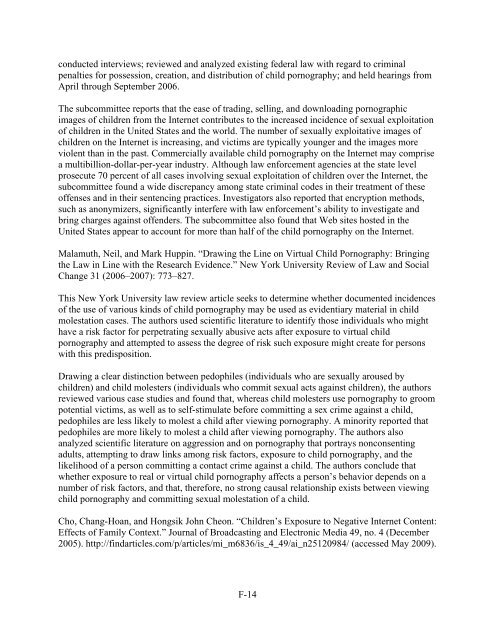The National Strategy for Child Exploitation Prevention and Interdiction
The National Strategy for Child Exploitation Prevention and Interdiction
The National Strategy for Child Exploitation Prevention and Interdiction
You also want an ePaper? Increase the reach of your titles
YUMPU automatically turns print PDFs into web optimized ePapers that Google loves.
conducted interviews; reviewed <strong>and</strong> analyzed existing federal law with regard to criminalpenalties <strong>for</strong> possession, creation, <strong>and</strong> distribution of child pornography; <strong>and</strong> held hearings fromApril through September 2006.<strong>The</strong> subcommittee reports that the ease of trading, selling, <strong>and</strong> downloading pornographicimages of children from the Internet contributes to the increased incidence of sexual exploitationof children in the United States <strong>and</strong> the world. <strong>The</strong> number of sexually exploitative images ofchildren on the Internet is increasing, <strong>and</strong> victims are typically younger <strong>and</strong> the images moreviolent than in the past. Commercially available child pornography on the Internet may comprisea multibillion-dollar-per-year industry. Although law en<strong>for</strong>cement agencies at the state levelprosecute 70 percent of all cases involving sexual exploitation of children over the Internet, thesubcommittee found a wide discrepancy among state criminal codes in their treatment of theseoffenses <strong>and</strong> in their sentencing practices. Investigators also reported that encryption methods,such as anonymizers, significantly interfere with law en<strong>for</strong>cement’s ability to investigate <strong>and</strong>bring charges against offenders. <strong>The</strong> subcommittee also found that Web sites hosted in theUnited States appear to account <strong>for</strong> more than half of the child pornography on the Internet.Malamuth, Neil, <strong>and</strong> Mark Huppin. “Drawing the Line on Virtual <strong>Child</strong> Pornography: Bringingthe Law in Line with the Research Evidence.” New York University Review of Law <strong>and</strong> SocialChange 31 (2006–2007): 773–827.This New York University law review article seeks to determine whether documented incidencesof the use of various kinds of child pornography may be used as evidentiary material in childmolestation cases. <strong>The</strong> authors used scientific literature to identify those individuals who mighthave a risk factor <strong>for</strong> perpetrating sexually abusive acts after exposure to virtual childpornography <strong>and</strong> attempted to assess the degree of risk such exposure might create <strong>for</strong> personswith this predisposition.Drawing a clear distinction between pedophiles (individuals who are sexually aroused bychildren) <strong>and</strong> child molesters (individuals who commit sexual acts against children), the authorsreviewed various case studies <strong>and</strong> found that, whereas child molesters use pornography to groompotential victims, as well as to self-stimulate be<strong>for</strong>e committing a sex crime against a child,pedophiles are less likely to molest a child after viewing pornography. A minority reported thatpedophiles are more likely to molest a child after viewing pornography. <strong>The</strong> authors alsoanalyzed scientific literature on aggression <strong>and</strong> on pornography that portrays nonconsentingadults, attempting to draw links among risk factors, exposure to child pornography, <strong>and</strong> thelikelihood of a person committing a contact crime against a child. <strong>The</strong> authors conclude thatwhether exposure to real or virtual child pornography affects a person’s behavior depends on anumber of risk factors, <strong>and</strong> that, there<strong>for</strong>e, no strong causal relationship exists between viewingchild pornography <strong>and</strong> committing sexual molestation of a child.Cho, Chang-Hoan, <strong>and</strong> Hongsik John Cheon. “<strong>Child</strong>ren’s Exposure to Negative Internet Content:Effects of Family Context.” Journal of Broadcasting <strong>and</strong> Electronic Media 49, no. 4 (December2005). http://findarticles.com/p/articles/mi_m6836/is_4_49/ai_n25120984/ (accessed May 2009).F-14
















